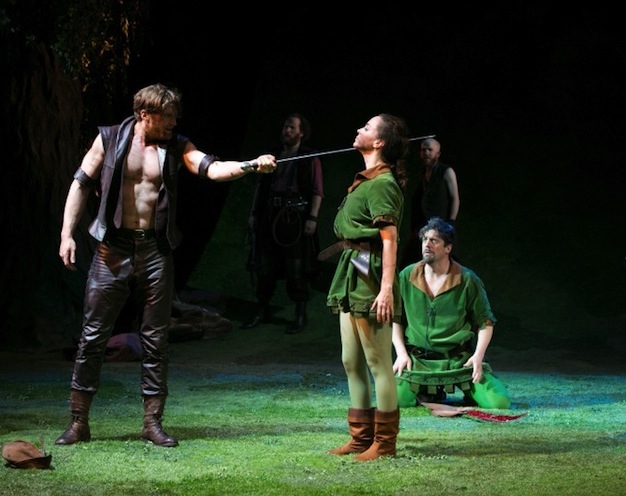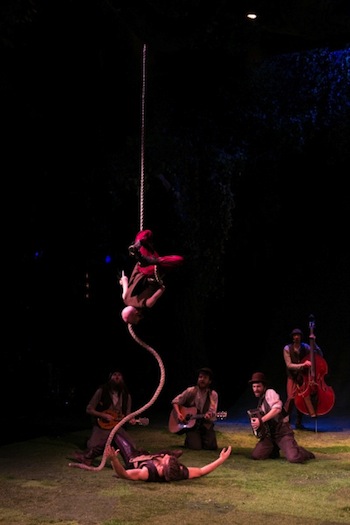Theater Review: An Amusing “Heart of Robin Hood”
What is refreshing about the muscular back-flipping in David Farr’s amusing rewrite of the Robin Hood fable is that Maid Marion is as much into derring-do as the Merry Men.
The Heart of Robin Hood, by David Farr. Directed by Gisli Örn Gardarsson. Music by Poor Old Shine. Lyrics by Poor Old Shine and David Farr. Set, Börkur Jónsson. Costumes, Emma Ryott. Staged by the American Repertory Theater at the Loeb Drama Center, Cambridge, MA, through January 19.

Jordan Dean (Robin Hood), Christina Bennett Lind (Marion), and Christopher Sieber (Pierre) in the A.R.T. production of “The Heart of Robin Hood.” Photo: Evgenia Eliseeva.
By Bill Marx
Artistic Director Diane Paulus, in the program notes for the American Repertory Theatre’s The Heart of Robin Hood, a revamping of a 2011 Royal Shakespeare Company rethinking of the venerable fable of Robin Hood, calls the interpretation “thrilling and kinetic.” “Kinetic” has become the house style at the A.R.T, where nary a production goes by without somebody doing something acrobatic on stage. (I await Paulus’s A Long Day’s Journey into Night on a Tightrope.) What is new about the muscular back-flipping in David Farr’s amusing rewrite of the Robin Hood fable is that Maid Marion is as much into derring-do as the men. Sherwood Forest comes off as a bucolic co-ed gym, where rival sports teams have at each other, tumblers and rope-climbers competing for the honors of doing good or evil.
The vision of a gym or a climbing wall is apt for Börkur Jónsson’s spectacular set, a steep green slope at the back of the stage down which characters slide, glide, and collide at various speeds. Doors and portholes open up to change the action to the castle or the church. On ground level there are additional holes that open up, including a mini-moat that hosts a shark and what might be a one-way entrance to the Underworld. The jumping-jacks physicality is one of the diverting merits to this production, which moves along via muscular antics and broad, campy humor. There’s a lot in the A.R.T program notes about Shakespeare, given that this Marion must disguise herself as a male (Martin of Sherwood) in order to bring Robin and his gang around to serving the cause of civilization. A misogynistic Robin demands that the Merry Men be a Women-hater’s Club (right out of The Little Rascals): with no sensitive females around they kill and rob without any thought about the poor or Christian morals. Marion has to prove herself as a warrior before she can conquer as a woman. (Paging Camille Paglia.)
Yes, there’s some of the Bard here in the gender-bending, but The Heart of Robin Hood has also been influenced by the formulas established by the mega-successful Disney cartoons, where the heroines are feistier and considerably more pumped-up than of yore. For political and cultural reasons the traditional female-in-distress, once a fount of virtue and good manners, no longer appeals: she must be an action hero as well. Rosalind in As You Like It delicately teaches Orlando the way to woo a woman—she doesn’t have to wrestle with him, or kick a bunch of baddies in the head, to bring him around. Neither does she have to redeem him from murderous behavior. In this rough and tumble feminized version of Robin Hood, Marion is the idealized figure of liberal piety, the best man and the best woman combined. (Her greedy, narrow-minded sister Alice serves as a farcical counterpart.) Farr’s humor, in its use of pop culture anachronisms (Jaws in the moat), self-conscious references to theatricality, exploitation of sing-a-long-ish music, and dependence on a clownish sidekick (Marion’s loyal and gay-ish servant, Pierre), also draws heavily on Disney conventions.
All of this cartoon mayhem and romance is lightly likable, especially for kids, helped by the bluegrass-ish music of the talented Connecticut group Poor Old Shine, though I have no idea why they are dressed as refugees from Appalachia and bounce about like Las Vegas lounge singers. Before the show began the musicians were in the aisle, playing up a storm as people were making their way to their seats. One of the problems with the fad for the “kinetic” is that directors don’t know when to stop and let us (and the performers) smell the roses—perpetual motion, from somersaults to handstands, becomes an end in itself. When in doubt, have somebody bound about on stage.
Luckily, the A.R.T performers are not only athletic, but generally create compelling caricatures. Christina Bennett Lind makes for a plucky, gee-whiz of a Marion, Jordan Dean, as Robin, has a petulant demeanor and washboard abs that are begging to be humanized, Christopher Sieber brings a Bob Hope-inspired, joke-machine panache to the quip-ready Pierre, Jeremy Crawford’s Little John scampers up ropes like a champion, and Damian Young’s Prince John is plenty villainous, though the performer wears out his decadently sardonic drawl. Sometimes you have to be direct and forgo putting a fancy aristo spin on every snarl. Check out the glorious Basil Rathbone in 1938’s The Adventures of Robin Hood.
The Heart of Robin Hood has a feminist kick, but it still reinforces my thesis that the circus ethos, at least as seen at the A.R.T. via Pippin and other three-ring productions, is politically conservative, perhaps for the sake of commercial viability. Little in this family-friendly show would dismay a non-foaming-at-the-mouth member of the Tea Party. The government is terrible on all levels—power hungry Prince John raises tax levels sky high to create an abusive police force; the “good” King Richard heads off to foreign lands, wasting blood and treasure in a useless war. The answer to oppression is a communal group of hunter/survivalists in the forest, predominately male, headed by a loving man and woman. (The medieval version of the Second Amendment would no doubt protect bows and arrows.) We hear a lot about the the hapless and helpless poor but they don’t get many lines (two “cute” kids run for their lives from Prince John, their dead parents appearing as gymnastic ghosts offering crucial advice). Pierre, the teller-of-the-tale, is apparently partnerless at the end of the story, even though he is surrounded by Merry Men. It would be nice if someone, sometime, would stretch Robin Hood’s heart beyond the conventional.


If I were to write a serious piece on Diane Paulus style theatre (I won’t!), I would call it “The Mainstreaming of Dionysus.” The Bacchae as a sorority bash. I’ll probably skip this Robin Hood.